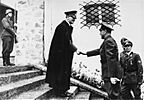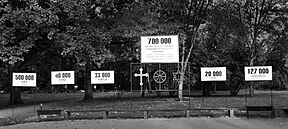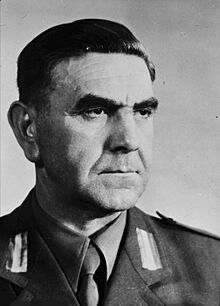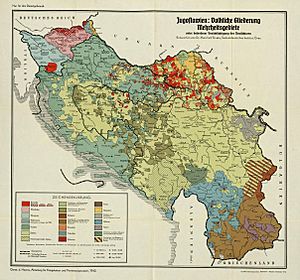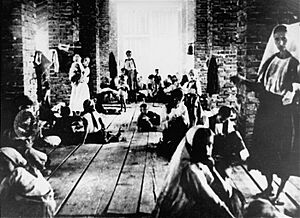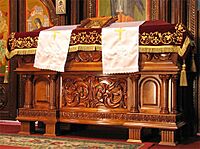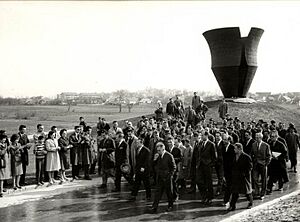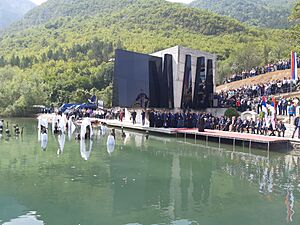Genocide of Serbs in the Independent State of Croatia facts for kids
Quick facts for kids Genocide of Serbs in the Independent State of Croatia |
|
|---|---|
| Part of World War II in Yugoslavia | |
|
(clockwise from top)
|
|
| Location |
|
| Date | 1941–1945 |
| Target | Serbs (largely Serbs of Croatia and Bosnia and Herzegovina) |
|
Attack type
|
Genocide, ethnic cleansing, massacres, deportation, forced conversion, others |
| Deaths | Several estimates:
|
| Victims | Ethnic cleansing:
|
| Perpetrators | Ustaše |
| Motive | Anti-Serb sentiment, Croatian irredentism, anti-Yugoslavism, Croatisation |
The Genocide of Serbs in the Independent State of Croatia was a terrible event during World War II. It involved the planned killing and removal of Serbs by the Ustaše government. This happened in the Independent State of Croatia (NDH) between 1941 and 1945. The NDH was a Nazi German puppet state, meaning it was controlled by Nazi Germany.
The Ustaše killed Serbs in death camps and through mass murder. They also forced many Serbs to leave their homes or change their religion. This was part of a plan to create a "pure" Croatian state. They also targeted Jews and Roma people.
The Ustaše movement had ideas from the 19th century. Some Croatian nationalists believed Serbs were an "inferior race." After World War I, the new country of Yugoslavia was formed. Tensions grew between different groups. The Ustaše, led by Ante Pavelić, became a very extreme group. They even helped kill King Alexander I.
When the Axis powers invaded Yugoslavia in 1941, the Independent State of Croatia (NDH) was set up. It included most of modern Croatia and Bosnia and Herzegovina. The Ustaše wanted to make this area only for Croats. They aimed to get rid of all non-Croats, especially Serbs. They built large concentration camps, like Jasenovac, where many people died. The NDH was the only Axis state to create camps just for children. Around 200,000 to 500,000 Serbs were killed. About 300,000 Serbs were forced to leave, and at least 200,000 were forced to change their religion.
After the war, some Ustaše leaders were tried for war crimes. Many escaped, including Ante Pavelić. The new Yugoslav government didn't fully investigate these events. They worried it would cause more ethnic problems. Today, Serbia and Croatia remember the victims on different dates.
Contents
- What Led to the Genocide?
- The Independent State of Croatia
- Concentration and Extermination Camps
- Mass Killings and Violence
- Forcing People to Leave and Change Religion
- Persecution Based on Religion
- How Many Victims and Why it's Called Genocide
- What Happened After the War
- Remembering the Victims
- In Culture
- See also
- Annotations
What Led to the Genocide?
Early Ideas of Croatian Nationalism
The Ustaše movement's ideas started in the 1800s. Ante Starčević and Josip Frank were key figures. They believed in a strong, independent Croatia. They were against the Habsburg Monarchy and against Serbs. Starčević thought Serbs were an "unclean race." He wanted a "Greater Croatia" that included areas where Serbs and Bosniaks lived. He saw them as Croats who had changed their religion.
Frank's group, called the Frankists, also strongly disliked Serbs. They saw Serbs as a problem for Croatian goals. Many Frankists later joined the Ustaše.
World War I and Yugoslavia's Creation
After World War I, the Austro-Hungarian Empire fell apart. The Kingdom of Serbs, Croats and Slovenes (later Yugoslavia) was formed. This new country was ruled by the Serbian Karađorđević dynasty. Many Croats, especially the Frankists, were against this. They saw Yugoslavia as a way for Serbs to dominate.
Some Croatian thinkers like Ivo Pilar and Milan Šufflay also influenced the Ustaše. They said Croats were from a "Nordic-Aryan" race. They claimed Serbs were a "degenerate race." These ideas helped the Ustaše believe Serbs were inferior.
Rise of Ante Pavelić and the Ustaše
Croatian nationalism grew stronger after 1918. Ante Pavelić, a lawyer and Frankist, became a leader for Croatian independence. In 1927, he met Benito Mussolini, Italy's fascist dictator. Pavelić wanted an independent Greater Croatia. Mussolini supported him to weaken Yugoslavia.
In 1928, a Serbian politician shot Stjepan Radić, a popular Croatian leader, in parliament. This caused big protests. King Alexander I then declared a dictatorship. He wanted to unite Yugoslavia, but this made separatist groups, like the Ustaše, even stronger.
The Ustaše movement started around 1929-1930. They hated Serbs deeply. They claimed Croats and Serbs were too different to live together. Pavelić said the Serbian government was spreading "barbarian culture." Ustaše leaders planned the genocide years before World War II. They wanted to "cleanse" the Croatian people. Their "Seventeen Principles" stated that non-Croats would not have political rights.
Historians explain that while there were some anti-Croatian policies in Yugoslavia, the Ustaše's extreme actions against Serbs were far worse. The Ustaše used past problems as an excuse for their terrible plans.
Ustaše as a Terrorist Group
The Ustaše also acted as a terrorist organization. They set up a center in Vienna and planned attacks. In 1932, they attacked a police station in Lika. In 1934, they helped kill King Alexander in France. Pavelić's ideas became more focused on race as he grew closer to Nazi Germany.
The Independent State of Croatia
Serbs (including Montenegrin Serbs)
Croats
Bosnian Muslims
Germans (Danube Swabians)
In April 1941, the Axis powers invaded Yugoslavia. On April 10, the Independent State of Croatia (NDH) was declared. Pavelić became its leader, called "Poglavnik." The NDH was a puppet state of Germany and Italy. About 30% of its population were Serbs.
The Ustaše wanted an "ethnically pure state." Their plan for Serbs was:
- Kill one-third of them.
- Expel one-third of them (force them to leave).
- Force one-third of them to convert to Catholicism.
Historians agree this plan was put into action.
The Ustaše had limited support from ordinary Croats. Many of their members were from extreme groups.
The NDH government was similar to Nazi Germany. They believed terror and genocide were needed to keep the state strong. Ustaše leaders called Serbs "unwanted elements" to be destroyed. Their ideas were based on Nazi racial theories. Like the Nazis, the Ustaše saw Jews, Romani, and Slavs as "sub-humans." They even claimed Croats were not Slavs but a Germanic race. Adolf Hitler supported Pavelić. Some historians believe the genocide in Croatia started before the Nazi killing of Jews.
Andrija Artuković, the NDH Minister of Interior, signed racial laws. These laws took away Serbs' citizenship and property. Serbs were forced to wear armbands with the letter "P" (for Orthodox). The Cyrillic script was banned, and Serbian words were removed from Croatian. Serbian schools were closed.
While the Ustaše's actions against Jews and Roma followed Nazi plans, their hatred for Serbs was deeply rooted in their own beliefs. The violence against Serbs varied, depending on local Ustaše leaders.
Concentration and Extermination Camps
The Ustaše quickly set up concentration camps in 1941. They presented these camps as "peaceful work camps" with photos of smiling prisoners.
Serbs, Jews, and Romani people were sent to camps like Jasenovac, Stara Gradiška, Gospić, and Jadovno. There were 22 to 26 camps in total. Jadovno was a place where prisoners were taken to pits and killed.
About 90,000 Serb victims died in these camps. Others were killed in "direct terror" like massacres and executions in villages.
The Jasenovac-Stara Gradiška complex was the largest and most terrible camp. About 100,000 people died there, mostly Serbs. Vjekoslav "Maks" Luburić, the camp commander, even boasted about how many people they had killed.
Jasenovac was divided into five camps. Stara Gradiška (Jasenovac V) held women and children. Ciglana (Jasenovac III) was the main killing place, with a very high death rate. It had a furnace used as a crematorium.

Camps for Children
The Independent State of Croatia was the only Axis state to build camps specifically for children. These included camps at Sisak, Đakovo, and Jastrebarsko. Stara Gradiška also held thousands of children.
Survivors described terrible cruelty towards children. Diana Budisavljević, an Austrian humanitarian, saved over 15,000 children from these camps.
Main Concentration and Death Camps
- Jasenovac (I–IV): Around 100,000 people died, at least 52,000 of them Serbs.
- Stara Gradiška (Jasenovac V): More than 12,000 people died, mostly Serbs.
- Gospić: Between 24,000 and 42,000 people died, mostly Serbs.
- Jadovno: Between 15,000 and 48,000 Serbs and Jews died.
- Sisak: 6,693 children passed through, mostly Serbs. Between 1,152 and 1,630 died.
- Jastrebarsko: 3,336 Serb children passed through. Between 449 and 1,500 died.
Mass Killings and Violence
The Ustaše Militia, along with other NDH forces, committed many massacres. This militia was mostly made up of uneducated people and workers. It also included some Muslims.
Violence against Serbs started in April 1941. At first, it targeted Serb leaders. But by July, it became widespread and systematic. Villages were burned, and thousands of Serbs were killed.
Historians note that many victims died in mass executions, not just in camps. The actions of German allies, like Croatia, played a big part in these killings.
Massacres in Central Croatia
- Gudovac massacre: On April 28, 1941, about 184–196 Serbs were killed near Bjelovar. This was one of the first mass killings by the Ustaše.
- Banski Grabovac: On July 24–25, 1941, the Ustaše killed all 1,100 Serb peasants in this village.
- Glina massacres: In May 1941, 260–300 Serbs were gathered in an Orthodox church in Glina and killed. The church was then set on fire. A similar event happened on July 30, 1941, where 700 Serbs were killed in a church. Only one person, Ljubo Jednak, survived by pretending to be dead.
Massacres in Lika
The Gospić area saw large massacres in July-August 1941, with about 3,000 Serb civilians killed. The Ustaše claimed Serbs were rebelling.
- Mlakva: On August 6, 1941, the Ustaše killed and burned over 280 villagers, including 191 children.
- Divoselo, Smiljan, Široka Kula: Over 900 Serbs were killed in Divoselo, over 500 in Smiljan, and over 400 in Široka Kula.
Massacres in Bosnian Krajina
- Sanski Most: In August 1941, between 2,800 and 5,500 Serbs were killed in and around Sanski Most.
- Kozarska Dubica: Over 7,000 Serbs were killed in this area. In January 1942, the village of Draksenić was burned, and over 200 people were killed.
- Banja Luka: In February 1942, Ustaše forces killed 2,300 adults and 550 children in Serb villages near Banja Luka.
- Garavice: From July to September 1941, thousands of Serbs, Jews, and Roma were killed at Garavice, near Bihać.
Massacres in Herzegovina
- Blagaj: On May 9, 1941, about 400 Serbs were rounded up and killed.
- Gacko: In June 1941, Ustaše forces killed about 170 men near Gacko by throwing them into a pit.
- Livno Field: Over 1,200 Serbs, including 370 children, were killed in this area.
- Prebilovci: From August 4–6, 1941, 650 women and children were killed near Šurmanci.
Massacres in Drina Valley
Many Serbs were killed by Ustaše forces along the Drina Valley. Jure Francetić's Black Legion killed thousands of unarmed Serb civilians. In 1942, about 6,000 Serbs were killed in Stari Brod.
Massacres in Sarajevo
In the summer of 1941, Ustaše forces arrested and killed groups of Sarajevo Serbs. They targeted church officials and educated people. At least 323 people were killed at the Villa Luburić.
Forcing People to Leave and Change Religion
The Ustaše wanted to create a purely Croat state by forcing Serbs to leave. The first to be expelled were World War I veterans. By mid-1941, 5,000 Serbs were sent to German-occupied Serbia. The plan was to remove important Serbs first, then take their property. By September 1941, about half of the Serbian Orthodox priests had been expelled.
The Drina is the border between the East and West. God’s Providence placed us to defend our border, which our allies are well aware and value, because for centuries we have proven that we are good frontiersmen.
—Mile Budak, a minister in the NDH government, August 1941.
The Ustaše compared these expulsions to other population exchanges in history. They set up camps to gather people for deportation. The NDH government also created an office to resettle Croats on the land taken from Serbs. Local people, including some Bosnian Muslims and Germans, helped with these expulsions.
About 120,000 Serbs were sent from the NDH to German-occupied Serbia. By 1943, 300,000 more had fled. In return, the NDH had to take over 200,000 Slovenian refugees who were forced out of their homes by the Germans.
Persecution Based on Religion
The Ustaše believed religion and nationality were connected. They saw Roman Catholicism and Islam as Croatian religions. But Eastern Orthodoxy was seen as a threat because it was linked to Serbs. They even saw their actions as a religious "crusade."
On May 3, 1941, a law was passed to pressure Serbs to convert to Catholicism. The Catholic Church in Croatia, led by Archbishop Aloysius Stepinac, accepted this law. The term "Serbian Orthodox" was banned. By September 1941, about half of the Serbian Orthodox priests were expelled.
To erase Serb history, many Orthodox churches were destroyed or used as stables.
The Ustaša movement is based on religion. Therefore, our acts stem from our devotion to religion and the Roman Catholic church.
—the chief Ustaše ideologist Mile Budak, 13 July 1941.
Ustaše propaganda said their actions were based on the historical conflict between Catholics and Orthodox Christians. After Serb uprisings began in July 1941, the government started a program for mass forced conversions. Many Orthodox churches were closed or destroyed, and priests were killed or imprisoned. The goal was to destroy the Serbian Orthodox Church.
The conversion policy had a strange rule: only uneducated Serbs could convert. Educated Serbs and Orthodox clergy were often targeted for expulsion or death.
The Vatican did not oppose these forced conversions. Pope Pius XII even blessed Ustaše members. Many Catholic priests joined the Ustaše and supported their actions.
Between 1941 and 1942, about 200,000 to 250,000 Serbs were forced to convert to Catholicism. However, most of them returned to Orthodoxy after the war. Sometimes, converts were still killed, even in the churches where they were baptized. About 85% of Serbian Orthodox clergy were killed or expelled.
The Encyclopedia of the Holocaust notes that Croatian bishops did not speak out against the forced conversions or the killings of Serbs and Jews. The Croatian Catholic Church and the Vatican saw the Ustaše's policies as good for Roman Catholicism.
The "Croatian Orthodox Church"
Because forced conversions caused problems, the NDH government created the Croatian Eastern Orthodox Church on April 3, 1942. This was meant to replace the Serbian Orthodox Church. A Russian archbishop, Germogen Maximov, became its head. This was an attempt to calm the state and make the remaining Serbs more "Croatian." However, persecution of Serbs still continued, though less intensely.
Persecution of Serbian Orthodox Clergy
Bishops of the Serbian Orthodox Church in the NDH were targeted.
- On May 5, 1941, Platon Jovanović of Banja Luka was killed.
- On May 12, Bishop Petar Zimonjić was killed.
- In mid-August, Bishop Sava Trlajić was killed.
- Bishop Dositej Vasić died from injuries after being tortured.
- Bishop Nikola Jovanović died after being beaten and expelled.
By December 1941, almost no Serbian Orthodox priests were left in the NDH. Around 214 to 217 were killed, and 334 were exiled.
The Role of Aloysius Stepinac
Aloysius Stepinac was the Archbishop of Zagreb during World War II. He pledged loyalty to the NDH. Historians debate how much he supported the Ustaše. He was not a strong supporter of all their policies, but he also didn't publicly condemn their crimes right away.
On May 14, 1941, Stepinac learned about the Glina massacres. He wrote to Pavelić, saying that such killings were against Catholic teaching. He asked Pavelić to stop the killings of Serbs. These were private letters at first. Later, in 1942 and 1943, he spoke more openly against the genocides.
Historian Jozo Tomasevich praised Stepinac's actions against the Ustaše. However, he also noted that Stepinac and the Catholic Church did not publicly condemn the genocide against Serbs earlier in the war. Tomasevich said their failure to do so "cannot be defended from the standpoint of humanity, justice and common decency."
In his diary, Stepinac wrote that Serbs and Croats were "two different worlds." Historian Ivo Goldstein said Stepinac was "a man with many dilemmas in a disturbing time."
How Many Victims and Why it's Called Genocide
It's hard to know the exact number of victims because many documents were destroyed. Also, different groups have different political reasons for their numbers.
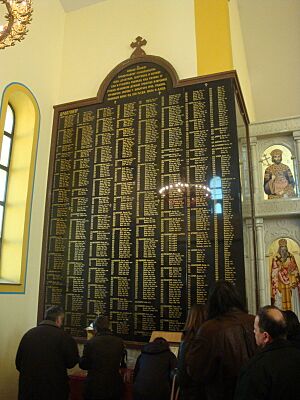
In the 1980s, Serb and Croat historians, Bogoljub Kočović and Vladimir Žerjavić, made careful estimates. Kočović estimated that 370,000 Serbs died in the NDH. Žerjavić estimated 322,000 Serb deaths, with 197,000 being civilians. He said about 78,000 civilians died in Ustaše camps. Current estimates for Jasenovac are around 100,000 total deaths, about half of them Serbs.
Historian Barbara Jelavich cites an estimate of 350,000 Serbs killed by the Ustaše. Rory Yeomans says conservative estimates are 200,000, but the actual number could be up to 500,000.
Historian Stanley G. Payne called the killings by the NDH regime an "extraordinary mass crime." He said that, compared to its population, the NDH's crimes were worse than almost any other European regime except Nazi Germany.
Many historians and experts, including Raphael Lemkin (who created the word genocide), say the Ustaše's mass killings of Serbs fit the definition of genocide. Croatian historian Mirjana Kasapović confirms that crimes against Serbs, Jews, and Roma in the NDH are clearly classified as genocide in important scientific works.
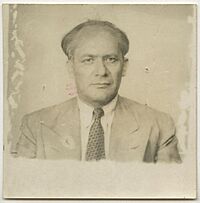
Yad Vashem, Israel's Holocaust memorial, states that the Ustaše carried out a "Serb genocide." They say over 500,000 Serbs were killed, 250,000 expelled, and 250,000 forced to convert. The Simon Wiesenthal Center also says NDH leaders committed genocide against Serbs, Jews, and Roma.
Presidents of Croatia and members of the Presidency of Bosnia and Herzegovina have also called the persecution of Serbs in the NDH a genocide.
The Serbian Orthodox Church considers the Serb victims of this genocide to be martyrs. They remember the Saint Martyrs of Jasenovac on September 13.
What Happened After the War
The new communist government in Yugoslavia did not fully use the Jasenovac camp for remembrance. They wanted to promote "brotherhood and unity" among different peoples. They worried that focusing on ethnic conflicts would make the country unstable. So, the genocide was not fully studied by independent scholars. Some historians say this genocide is "lesser-known" in the Western world.
The events of World War II, especially the ethnic conflicts, are seen as a cause for the later Yugoslav Wars (1991–95).
Trials of War Criminals
Mile Budak and other NDH government members were tried and found guilty of high treason and war crimes. Many were executed. Miroslav Filipović, a commander of Jasenovac and Stara Gradiška camps, was also executed.
Many Ustaše leaders escaped, mostly to Latin America. Some were caught, like Ljubo Miloš, a Jasenovac commander, who was executed. Aloysius Stepinac was found guilty of treason and forced conversions.
Andrija Artuković, who signed racial laws, escaped to the United States. He was sent back to Yugoslavia in 1986 and found guilty of mass killings. He was sentenced to death but died in prison due to age and health. Dinko Šakić, another Jasenovac commander, was caught in the 1990s. He was tried in Croatia and sentenced to 20 years in prison.
Escapes and Terrorist Groups
After the war, many Ustaše leaders fled. Some hid near the Vatican. A Catholic priest, Krunoslav Draganović, helped them escape. The US government also helped some war criminals. Many responsible for killings found refuge in South America, Portugal, Spain, and the United States.
Some Croat groups living outside Yugoslavia saw the Ustaše as heroes. These groups carried out terrorist attacks, like bombings and plane hijackings, during the Yugoslav period.
Remembering the Victims

Leaders like Israeli Presidents Moshe Katsav and Shimon Peres have visited Jasenovac to honor the victims.
The Jasenovac Memorial Museum reopened in 2006. It has exhibits with artifacts, videos, and glass panels with victims' names.
In New York City, a public monument to Jasenovac victims was set up in 2005. It is the only such monument outside the Balkans.
Today, on 22 April, Serbia marks the National Holocaust, World War II Genocide and other Fascist Crimes Victims Remembrance Day. Croatia holds an official ceremony at the Jasenovac Memorial Site. Serbia and the Bosnian entity of Republika Srpska hold a joint ceremony at the Donja Gradina Memorial Zone.
In 2018, an exhibition called “Jasenovac – The Right to Remembrance” was held at the Headquarters of the United Nations in New York City. Its goal was to remember the Serb, Jewish, Roma, and anti-fascist victims of the Holocaust and genocide at Jasenovac.
Ceremonies also take place for victims of the Jadovno concentration camp and the Jastrebarsko children's camp.
In Culture
Books
- Jama (The Pit): A poem by Ivan Goran Kovačić about the Ustaše crimes.
- Eagles Fly Early: A novel by Branko Ćopić about children helping the Partisans against the Ustaše.
Art
- Zlatko Prica and Edo Murtić created art based on the poem Jama.
Theater
- Golubnjača: A play by Jovan Radulović about ethnic relations after the Ustaše crimes.
Movies
- 1955 – Šolaja: About a Serb rebellion against the genocide.
- 1960 – The Ninth Circle: Includes scenes from the Jasenovac camp.
- 2020 – Dara of Jasenovac: A film about a girl who survived the Jasenovac camp.
TV Series
- 1981 – Nepokoreni grad: About the Ustaše terror campaign.
Music
- Some survivors say the lyrics of the famous song "Đurđevdan" were written on a train taking prisoners to Jasenovac.
- The Croatian band Thompson has a controversial song called "Jasenovac i Gradiška Stara" that some say glorifies the Ustaše.
See also
- Anti-Eastern Orthodox sentiment
- Catholic clergy involvement with the Ustaše
Annotations




